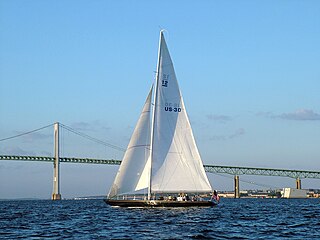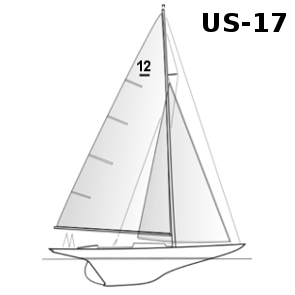
Yacht racing is a sailing sport involving sailing yachts and larger sailboats, as distinguished from dinghy racing, which involves open boats. It is composed of multiple yachts, in direct competition, racing around a course marked by buoys or other fixed navigational devices or racing longer distances across open water from point-to-point. It can involve a series of races with buoy racing or multiple legs when point-to-point racing.

The America's Cup, informally known as the Auld Mug, is a trophy awarded in the sport of sailing. It is the oldest international competition still operating in any sport. America's Cup match races are held between two sailing yachts: one from the yacht club that currently holds the trophy and the other from the yacht club that is challenging for the cup. There is no fixed schedule, with matches held several years apart on dates agreed between the defender and the challenger. The most recent America's Cup match took place in March 2021.
Sailing/Yachting is an Olympic sport starting from the Games of the 1st Olympiad. With the exception of the 1904 and the canceled 1916 Summer Olympics, sailing has always been included on the Olympic schedule. The Sailing program of 1908 was open for a total of five sailing classes (disciplines), but actually only four Sailing events were contested. The planned venue of all races, named matches, was Ryde, Isle of Wight.

The 12 Metre class is a rating class for racing sailboats that are designed to the International rule. It enables fair competition between boats that rate in the class whilst retaining the freedom to experiment with the details of their designs. The designation "12 Metre" does not refer to any single measurement on the boat, and is not referencing the vessels overall length, rather, measures the sum of the components directed by the formula which governs design and construction parameters. Typically 12 Metre class boats range from 65 to 75 feet in length overall; they are most often sloop-rigged, with masts roughly 85 feet tall.
The Universal Rule determined a yacht's eligibility to race in the America's Cup from 1914 to 1937 and for this the J-class was chosen. Boats built according to the rule reached their peak in the large J-class yachts. This Rating Rule is intended to calculate a rating for yachts, which can then be used to calculate its Time Correction Factor (T.C.F.) in order to have disparate yachts racing against each other. The first boat said to be built under the universal rule was Herreshoff's Doris built in 1905.

Intrepid is a 12-metre class racing yacht which won the America's Cup in 1967 and again in 1970.

The 2007 America's Cup was the thirty-second challenge for the America's Cup and was won by Alinghi in the 7th race. The Cup is the most famous and most prestigious regatta and Match Race in the sport of sailing.
Olin James Stephens II was an American yacht designer. Stephens was born in New York City, but spent his summers with his brother Rod, learning to sail on the New England coast. He also attended the Massachusetts Institute of Technology for a term.
Sailing/Yachting is an Olympic sport starting from the Games of the 1st Olympiad (1896 Olympics in Greece. With the exception of 1904 and the canceled 1916 Summer Olympics, sailing has always been included on the Olympic schedule. The Sailing program of 1956 consisted of a total of five sailing classes. For each class seven races were scheduled from 26 November to 5 December 1956 at Port Phillip Bay.
Courageous is a 12-metre class racing yacht. It was the third boat to win the America's Cup twice, in 1974 and 1977, after Columbia in 1899 and 1901, and Intrepid in 1967 and 1970. All three yachts were fielded by the New York Yacht Club. The Olin J. Stephens-designed sloop was the first all aluminum-hulled 12-metre class yacht.

The 1987 America's Cup was the twenty-sixth challenge for the America's Cup.
The 1988 America's Cup was the 27th America's Cup regatta, and was contested between the defender, San Diego Yacht Club represented by Stars & Stripes H3, and the challenger, the Mercury Bay Boating Club represented by New Zealand Challenge's KZ-1. Run under strict Deed of Gift rules, the regatta was won by the San Diego Yacht club, in a two-race sweep.
Thomas David Blackaller, Jr. was a world-champion American yachtsman, America's Cup helmsman, sailmaker, and racecar competitor. He was a two-time world champion in the Star class keelboat, a world champion in the international Six metre class, raced in three separate America's Cup campaigns, and influenced the careers of many other sailors.
Henry Sears was an American commander and a commodore of the New York Yacht Club who competed in the America's Cup and discovered multiple species of marine fish.

The 34th America's Cup was a series of yacht races held in San Francisco Bay on September 2013. The series was contested between the defender Oracle Team USA representing the Golden Gate Yacht Club, and the challenger Emirates Team New Zealand representing the Royal New Zealand Yacht Squadron. Oracle Team USA defended the America's Cup by a score of 9 to 8 after winning eight consecutive races from Race 12 onwards. Team New Zealand won the right to challenge for the Cup by previously winning the 2013 Louis Vuitton Cup. The 34th America's Cup's race schedule was the longest ever, in terms of number of days and number of races, and the first since the 25th America's Cup to feature both teams in a match point situation. In addition for the first time since 1995, the format of the schedule changed so that the winner emerged from the best of 17 races.

The 1962 America's Cup, the second to be sailed in 12-metre yachts, marked the first challenge for the Cup from a country other than Great Britain or Canada, and was the first challenge from a country in the southern hemisphere. An Australian syndicate headed by Sir Frank Packer, representing the Royal Sydney Yacht Squadron, challenged with their yacht Gretel. Although the New York Yacht Club won the regatta four races to one represented by the yacht Weatherly, the challenger, Gretel won the second race, beating the Americans for the first time since the 1930s, and only lost the fourth race by twenty-six seconds. The NYYC was so shocked at the closeness of the contest that they immediately changed the rules to ban the use of American design and technology by Cup challengers.
Roderick Stephens, Jr. was one of America's best known and respected sailors. In 1933 he became Associate Designer, later promoted to President, of Sparkman & Stephens naval architecture and yacht design firm, a company founded in 1929 by his brother Olin Stephens and Drake Sparkman.

Columbia (US-16) was the successful defender of the 1958 America's Cup for the New York Yacht Club, besting the British challenger Sceptre.

Weatherly is a 12-metre racing yacht that was an unsuccessful defense candidate for the 1958 America's Cup and victorious defender in the 1962 America's Cup.

Sappho was one of two defender yachts at the second America's Cup challenge, stepping in when defender Columbia was damaged in the third race.










